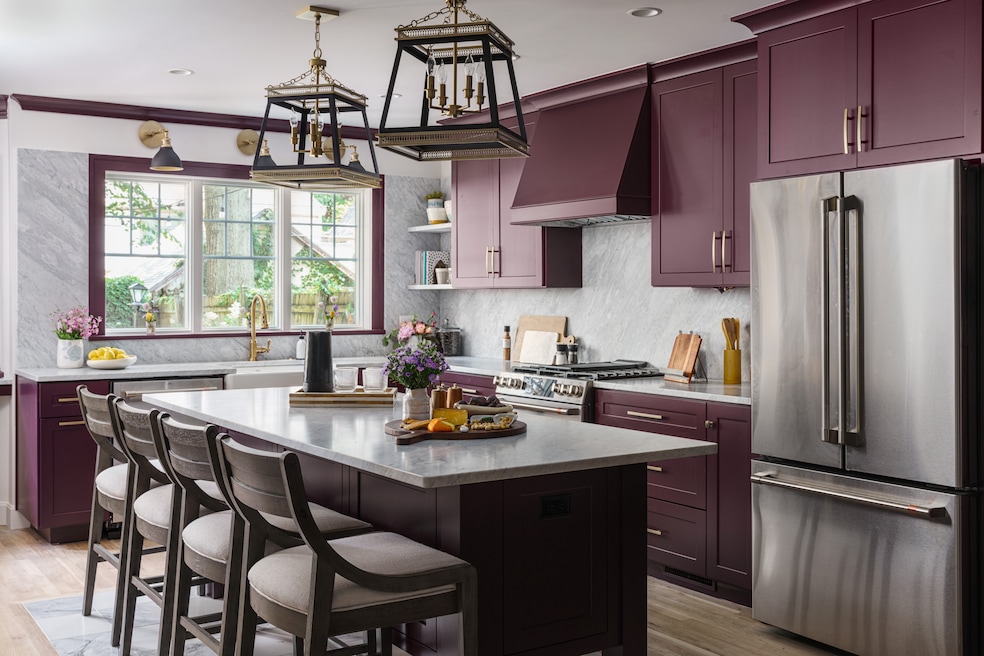With home prices at record highs, Americans are choosing to stay put and invest in remodels, reimagining their spaces with more personal, bold design choices.
The most popular way of achieving that look is through color, industry professionals say.
“It’s really all about colors, and it’s not one trend of color. It’s any and all colors,” Tamara Day, interior designer and host of "Bargain Mansions" on the Magnolia Network, said in an interview. “We are tired of the all-white, and we want to see something new.”
At Design & Construction Week, an annual trade show in Las Vegas, brands fully embraced this idea, releasing colorful products in expanded shades to meet demand and provide more options. It’s a dramatic shift from the popularity of white and gray rooms in recent years.
Only a minority of designers and contractors the National Kitchen and Bath Association surveyed in 2024 predicted that the “white everywhere” trend of the 2000s would prevail in the next three years. That’s a strong decline from whites being picked as the top color scheme in kitchens by nearly half of survey respondents in 2020.
Gray is not immune to going out of style, either. The term “millennial gray” on social media has become a jab of sorts, mocking what are seen as soulless interiors preferred by Americans born between the early 1980s and late 1990s. The younger Generation Z, meanwhile, appears to denounce the neutral approach, according to design experts.

Brands go beyond stainless steel
To meet the increase in demand for colorful homes, major appliance brands have expanded product lines to welcome new, unconventional hues. And since appliances are typically the priciest part of a room and more difficult to swap out, the move toward color is evidence that choices of juniper, port and olive have more staying power.
True Residential and KitchenAid both launched green hues for their refrigerators and ovens, one of the most popular colors among homeowners. GE also showcased jade and sapphire, a green and blue colorway for its washers and dryers.
“We noticed that green was becoming a new neutral,” said Brittni Pertijs, design manager at Whirlpool. “Everyone’s doing different greens in the kitchen.”
Designers consider blue and green safe colors, entry-level choices for nervous homeowners concerned about resale, but designer Day loves a more daring hue.

“I’m using all kinds of deep colors, not just the green and blues,” she said. “We’ve done a burgundy kitchen, we’ve done purple cabinetry, we’ve done bright blue cabinetry, yellow cabinetry — you name it, we’re using color.”
Manufacturers supplying color options is a big draw for designers who find themselves curating custom, color-drenched homes. Toto debuted its first non-white products: four sinks of varying shades representing the four seasons. Kast, a bathroom brand known for its color, displayed concrete basins that combined up to three colors for maximum personality.
“If I can get a teal-colored toilet and sink in a powder room, I’m doing it,” said Amber Guyton, the designer behind interior design firm Blessed Little Bungalow.
Brands showcased saturated kitchens on the Design & Construction Week show floor, especially purples and reds. True Residential featured a monochromatic burgundy kitchen scene, while GE’s Cafe line went full purple color drench.
“I think people are tired of playing it safe,” Guyton said. “I’m going to pick out colors and fixtures and finishes that really speak to me.“

How colors can affect sales
Neutral colors do have their place. It’s typical to opt for white or gray when considering resale, but with more homeowners hanging on to their low mortgage rates and choosing to remodel, it’s less of a concern, designers and brokers say.
“This one man said: ‘I’m married to my mortgage rate. Unless I get a divorce, I’m not going anywhere,’” said suburban Chicago agent Maria Campanella DelBoccio of @properties Christie’s International Real Estate. “Everything was white and gray for so long. People are staying in their homes. They’re making those changes now.”
DelBoccio sees more colorful homes hitting the market in the next five years, but if high prices and low inventory persist, a personalized, visually striking home could have little to no impact on how quickly it sells. The agent said a typical listing undergoes a to-do list for neutralizing the space and staging, yet neither is required in a demanding market.
“I can’t tell you the last time I staged a house,” said DelBoccio.
Part of deciding whether or not to create vibrant custom spaces comes down to the influence of social media, noted Day, which contributes to a shorter lifespan of trends, but inspires and encourages homeowners to develop their own style.
“Social media has taught us to do what we love, not what everybody else loves,” Day said. “Trends come and go really, really fast nowadays. They’re much faster than they used to be, and so it’s all about doing what you love in your home and what will make you happy because in 10 years, nobody is going to like it, you’re going to have to redo it anyway.”
